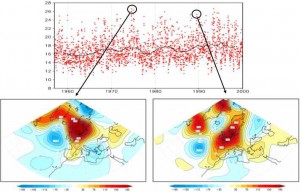KNMI – An Objective Method to Associate Local Weather Extremes #SWI2009
Local weather extremes, like heavy rainfall or extreme temperatures, are usually connected to characteristic circulation patterns in the atmosphere. The figure below illustrates this fact for daily mean temperatures in July and August as observed in De Bilt. For two periods with extremely high temperatures the atmospheric circulation deviation from the time-mean flow as characterized by the height of the 500 hPa pressure level is plotted. Red indicates positive height anomalies, blue negative. The air flows along the isolines at speeds proportional to the gradient. In 1975 a high-pressure anomaly was located above Scandinavia leading to the advection of warm, dry continental air into the Netherlands by the easterly winds and local extreme heat. In the late eighties, a high-pressure anomaly was located right above the Netherlands with clear skies, no wind, an abundance of sunshine, and as a result, extremely high temperatures. Thus different circulation patterns give rise to similar local temperature extremes.
We would like to have an objective method that finds characteristic circulation patterns that are in some sense optimally connected to local extreme values of a particular weather variable, like rain or temperature.
This method would enable us to investigate whether in the future, in warmer climate, these patterns occur more often and change the probability of local weather extremes.


